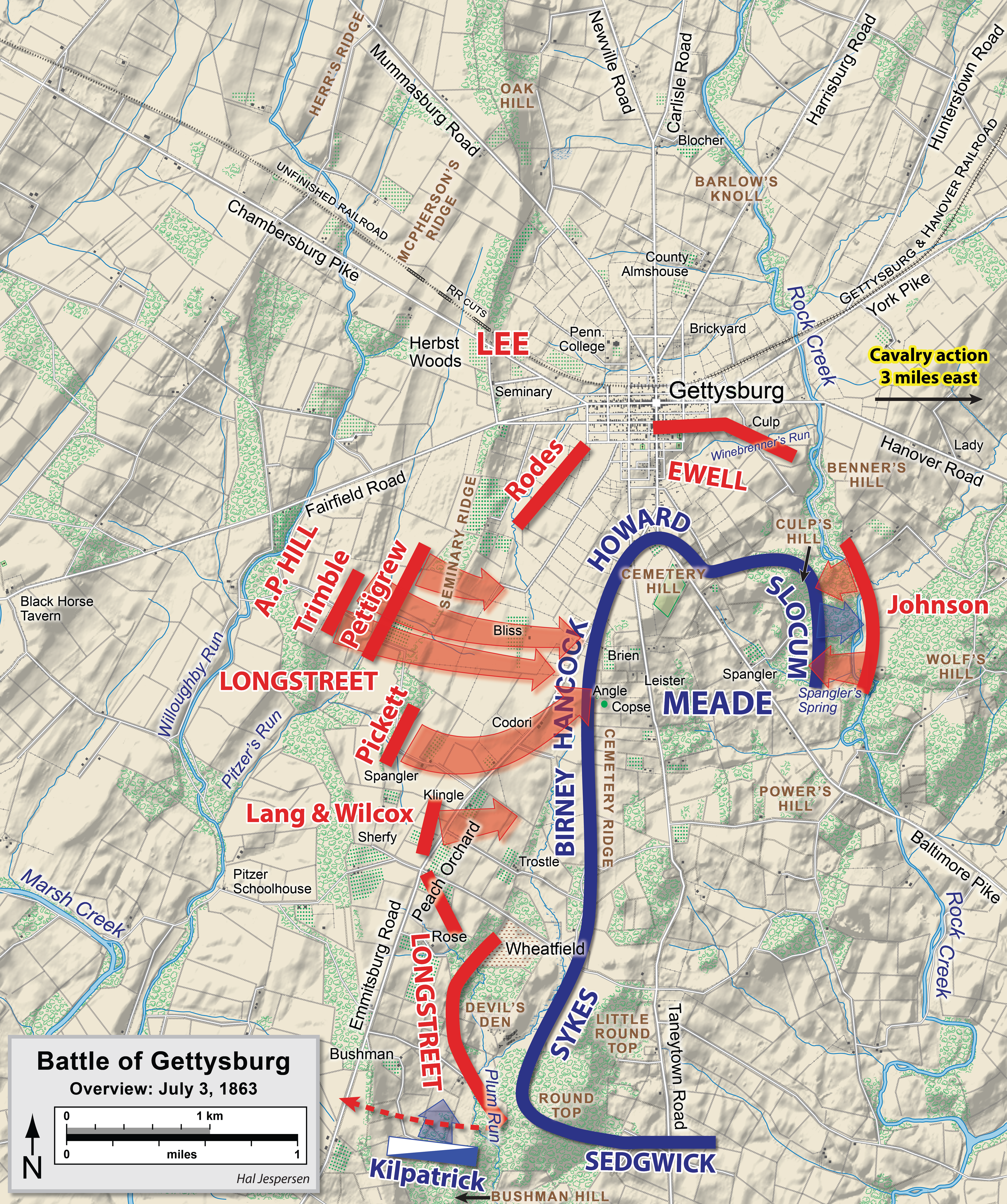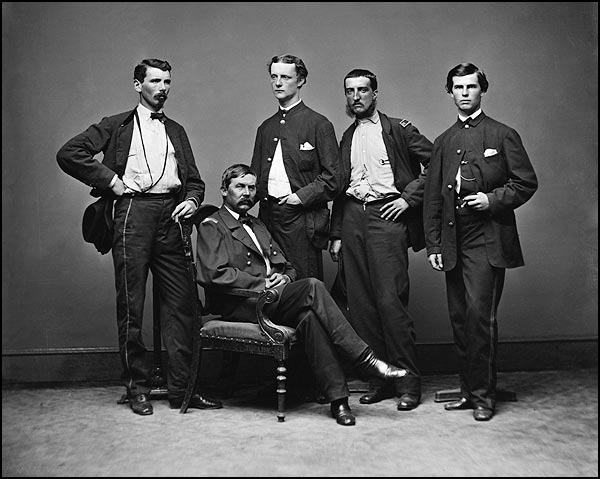|
Cemetery Ridge
Cemetery Ridge is a geographic feature in Gettysburg National Military Park, south of the town of Gettysburg, Pennsylvania, that figured prominently in the Battle of Gettysburg, July 1 to July 3, 1863. It formed a primary defensive position for the Union Army during the battle, roughly the center of what is popularly known as the "fish-hook" line. The Confederate States Army launched attacks on the Union positions on the second and third days of the battle, but were driven back both times. Description The ridge rises only about above the surrounding terrain and is under long. The northern end rises to become Cemetery Hill, the southern descends to low, wooded, and sometimes marshy ground just north of Little Round Top. At the northern end of Cemetery Ridge is a copse of trees and a low stone wall that makes two 90-degree turns; the latter has been nicknamed '' The Angle'' and is also referred to as ''the High Water Mark of the Confederacy''. This area, and the nearby Codori F ... [...More Info...] [...Related Items...] OR: [Wikipedia] [Google] [Baidu] |
Gettysburg Battlefield
The Gettysburg Battlefield is the area of the July 1–3, 1863, military engagements of the Battle of Gettysburg in and around Gettysburg, Pennsylvania. Locations of military engagements extend from the site of the first shot & at Knoxlyn Ridge on the west of the borough, to East Cavalry Field on the east. A military engagement prior to the battle was conducted at the Gettysburg Railroad trestle over Rock Creek (Monocacy River tributary), Rock Creek, which was burned on June 27. Geography Within of the Mason-Dixon line, Maryland/Pennsylvania state line, the Gettysburg battlefield is situated in the Geology of Pennsylvania#Gettysburg-Newark Lowlands, Gettysburg-Newark Basin of the Pennsylvania Regions#Pennsylvania Piedmont, Pennsylvania Piedmont entirely within the Potomac River Watershed near the Marsh and Rock creeks' triple point, with the Susquehanna River Watershed (near Oak Hill) occupying an area . Military engagements occurred within and around the borough of Gettysb ... [...More Info...] [...Related Items...] OR: [Wikipedia] [Google] [Baidu] |
Abner Doubleday
Abner Doubleday (June 26, 1819 – January 26, 1893) was a career United States Army officer and Union major general in the American Civil War. He fired the first shot in defense of Fort Sumter, the opening battle of the war, and had a pivotal role in the early fighting at the Battle of Gettysburg. Gettysburg was his finest hour, but his relief by Maj. Gen. George G. Meade caused lasting enmity between the two men. In San Francisco, after the war, he obtained a patent on the cable car railway that still runs there. In his final years in New Jersey, he was a prominent member and later president of the Theosophical Society. In 1908, 15 years after his death, the Mills Commission declared that Doubleday had invented the game of baseball, although Doubleday never made such a claim. This claim has been thoroughly debunked by baseball historians.Kirsch, pp. xiii–xiv. Early years Doubleday, the son of Ulysses F. Doubleday and Hester Donnelly, was born in Ballston Spa, N ... [...More Info...] [...Related Items...] OR: [Wikipedia] [Google] [Baidu] |
John Gibbon
John Gibbon (April 20, 1827 – February 6, 1896) was a career United States Army officer who fought in the American Civil War and the Indian Wars. Early life Gibbon was born in the Holmesburg, Philadelphia, Pennsylvania, Holmesburg section of Philadelphia, Pennsylvania, the fourth child of 10 born to Dr. John Heysham Gibbons and Catharine Lardner Gibbons. He was the brother of Lardner Gibbon, publisher of ''Exploration of the Valley of the Amazon''. When Gibbon was nearly 11 years old, the family moved near Charlotte, North Carolina, after his father took a position as chief assayer at the U.S. Mint. He graduated from the United States Military Academy in 1847 and was commissioned a brevet (military), brevet Second Lieutenant#United States, second lieutenant in the 3rd Air Defense Artillery Regiment, 3rd U.S. Artillery. He served in the Mexican–American War without seeing combat, attempted to keep the peace between Seminoles and settlers in south Florida, and taught artil ... [...More Info...] [...Related Items...] OR: [Wikipedia] [Google] [Baidu] |
Alexander Hays
Alexander Hays (July 8, 1819 – May 5, 1864) was a Union Army general in the American Civil War who was killed at the Battle of the Wilderness in 1864. Early life and career Hays was born in Franklin, Pennsylvania, the son of Samuel Hays, a member of Congress and general in the Pennsylvania militia. He studied at Allegheny College and then transferred to the United States Military Academy in his senior year, graduating in 1844, ranking 20th out of 25 cadets. Among his classmates were future Civil War generals Alfred Pleasonton and Winfield S. Hancock. He became a close personal friend of Ulysses S. Grant, who had graduated the year before. Hays was brevetted as a second lieutenant in the 8th U.S. Infantry. He served in the Mexican–American War, and won special distinction in an engagement near Atlixco. In April 1848, he resigned his commission in the army and returned to Pennsylvania. He settled in Venango County, where he engaged in the manufacture of iron from 1848 ... [...More Info...] [...Related Items...] OR: [Wikipedia] [Google] [Baidu] |
George Meade
George Gordon Meade (December 31, 1815 – November 6, 1872) was an American military officer who served in the United States Army and the Union army as Major General in command of the Army of the Potomac during the American Civil War from 1863 to 1865. He fought in many of the key battles of the Eastern theater and defeated the Confederate Army of Northern Virginia led by General Robert E. Lee at the Battle of Gettysburg. He was born in Cádiz, Spain, to a wealthy Philadelphia merchant family and graduated from the United States Military Academy in 1835. He fought in the Second Seminole War and the Mexican–American War. He served in the United States Army Corps of Topographical Engineers and directed construction of lighthouses in Florida and New Jersey from 1851 to 1856 and the United States Lake Survey from 1857 to 1861. His Civil War service began as brigadier general with the Pennsylvania Reserves, building defenses around Washington D.C. He fought in the Penins ... [...More Info...] [...Related Items...] OR: [Wikipedia] [Google] [Baidu] |
Army Of The Potomac
The Army of the Potomac was the primary field army of the Union army in the Eastern Theater of the American Civil War. It was created in July 1861 shortly after the First Battle of Bull Run and was disbanded in June 1865 following the Battle of Appomattox Court House, surrender of the Confederate Army, Confederate Army of Northern Virginia in April. History The Army of the Potomac was founded in 1861. It initially was only the size of a corps relative to the size of Union armies later in the American Civil War, Civil War. Its nucleus was called the Army of Northeastern Virginia led by Brigadier general (United States), Brig. Gen. Irvin McDowell. It fought and lost the Civil War's first major battle, the First Battle of Bull Run. The arrival in Washington, D.C., of Major general (United States), Maj. Gen. George B. McClellan dramatically changed the makeup of that army. McClellan's original assignment was to command the Division of the Potomac, which included the Department of ... [...More Info...] [...Related Items...] OR: [Wikipedia] [Google] [Baidu] |
Battle Of Gettysburg, Second Day
During the second day of the Battle of Gettysburg (July 2, 1863) Confederate Gen. Robert E. Lee attempted to capitalize on his first day's accomplishments. His Army of Northern Virginia launched multiple attacks on the flanks of the Union Army of the Potomac, commanded by Maj. Gen. George G. Meade. The assaults were unsuccessful, and resulted in heavy casualties for both sides. Early in the afternoon, Union Maj. Gen. Daniel Sickles repositioned his III Corps forward in a salient without authorization in the hopes of occupying slightly elevated ground to his front. After a short delay to assemble his forces and avoid detection in his approach march, Lt. Gen. James Longstreet attacked with his First Corps against the Union left flank. His division under Maj. Gen. John Bell Hood attacked Little Round Top and Devil's Den. To Hood's left, Maj. Gen. Lafayette McLaws attacked the Wheatfield and the Peach Orchard. Although neither prevailed, the Union III Corps was effective ... [...More Info...] [...Related Items...] OR: [Wikipedia] [Google] [Baidu] |
Seminary Ridge
Seminary Ridge is a dendritic ridge that served as an area of military engagements during the Battle of Gettysburg, the bloodiest battle of the American Civil War, which was fought between July 1 and July 3, 1863 in and around Gettysburg, Pennsylvania. Seminary Ridge also served as a military installation during World War II. Geography Seminary Ridge is a northern portion of the drainage divide between the Marsh Creek Watershed on the west and the Rock Creek Watershed on the east. At the south end of Oak Ridge, the northernmost portion of the divide, the north-south McPherson and Seminary ridges bifurcate southward at the triple watershed point of Willoughby's and Pitzer runs southward tributaries of Marsh Creek with a Rock Creek eastward tributary. From the triple point, Seminary Ridge extends southward to an area with eastward drainage into Stevens Creek, with the borough of Gettysburg. Farther south into the Gettysburg National Park, Seminary Ridge continues as far as ... [...More Info...] [...Related Items...] OR: [Wikipedia] [Google] [Baidu] |
John Buford
John Buford Jr. (March 4, 1826 – December 16, 1863) was a United States Army cavalry officer. He fought for the Union Army, Union during the American Civil War, rising to the rank of brigadier general. Buford is best known for his actions in the Battle of Gettysburg, First Day, first day of the Battle of Gettysburg on July 1, 1863, by identifying Cemetery Hill and Cemetery Ridge as high ground that would be crucial in the impending battle, and by placing vedettes (the cavalry equivalent of "picket lines") to the west and north that delayed the enemy long enough for the Union Army to arrive. Born in the divided Border states (American Civil War), border state of Kentucky, Buford graduated from United States Military Academy, West Point in 1848. He remained loyal to the United States when the Civil War broke out and fought against the Confederate Army, Confederate Army of Northern Virginia as part of the Army of the Potomac. His first command was a cavalry brigade under Major gene ... [...More Info...] [...Related Items...] OR: [Wikipedia] [Google] [Baidu] |
John W
John is a common English name and surname: * John (given name) * John (surname) John may also refer to: New Testament Works * Gospel of John, a title often shortened to John * First Epistle of John, often shortened to 1 John * Second Epistle of John, often shortened to 2 John * Third Epistle of John, often shortened to 3 John People * John the Baptist (died ), regarded as a prophet and the forerunner of Jesus Christ * John the Apostle (died ), one of the twelve apostles of Jesus Christ * John the Evangelist, assigned author of the Fourth Gospel, once identified with the Apostle * John of Patmos, also known as John the Divine or John the Revelator, the author of the Book of Revelation, once identified with the Apostle * John the Presbyter, a figure either identified with or distinguished from the Apostle, the Evangelist and John of Patmos Other people with the given name Religious figures * John, father of Andrew the Apostle and Saint Peter * Pope John (disambigu ... [...More Info...] [...Related Items...] OR: [Wikipedia] [Google] [Baidu] |





